 |
  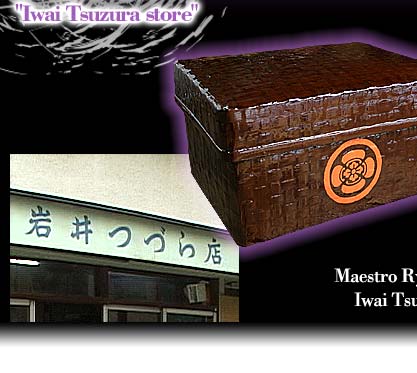 |
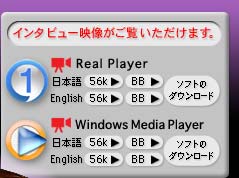 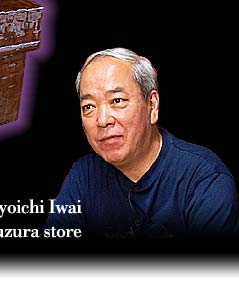 |
 |
Tsuzura is a craftwork that was first made by craftsmen in Kanda, Tokyo, early in the Genroku era. Although there were more than 250 tsuzura stores all over Japan at the beginning of the Showa era, there are only two stores left in Tokyo today. One of them is "Iwai Tsuzura ten" in Chuo-ku. The popularity of tsuzura has been growing again recently, not just as a container for kimono or accessories but as a home decoration and a gift for overseas.
This month, we introduce maestro Ryoichi Iwai of "Iwai Tsuzura-ten," located on Amazake Yokocho Street, Nihonbashi, the only store that crafts and sells Tsuzura products in Chuo-ku today. The store was established at the end of the Edo era, and has been handing down the traditional technique of crafting "Tsuzura" for the past 200 years, since the 17th Century. |
 |
 |
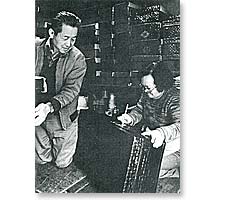 |
| Past and Present |
 |
| The establishment of the store was at the end of the Edo era. My grandfather had the store on Amazake yokocho street in the Meiji era, so our family has handed down traditional Tsuzura craftsmanship at this particular place. It has already been 23 years since I quit working for a company when I was 32 in 1981 and then started working for my family business. Tsuzura seems to have been used in Japan regularly at every house to put kimono and accessories away, since they let air through and kept moths away. Since there were lots of kimono stores in Nihonbashi in the Edo era, tsuzura stores were also everywhere. However, as lifestyles change with a decline in kimono culture in Japan, the number of tsuzura store have gradually decreased as well. |
| The wall which stands in handing down techniques |
 |
| At our store, we put "washi” - Japanese rice paper made in Ogawa city in Saitama, over the bamboo basket weaved by a bamboo craftsman in Sado, Tateyama or Kyoto, to strengthen the basket. Then, we paint with a mixture of persimmon and tannin over the paper for base coating, which holds the lacquer. I inherited this special technique from my father but it took me seven to eight years to learn it. Although I strongly hope to hand down these traditional technique to the next generation, I strongly doubt my children will inherit it because in the division of labor, other craftsmen such as basket makers and lacquerware brush makers are also decreasing. The brushes sold at home centers are not thick enough for our work. Thinking from various angles, it is difficult to pass down all these techniques to next generations, I hate to say. |
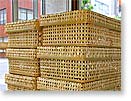 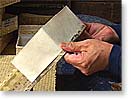 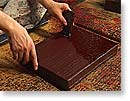
| 1.bamboo baskets |
|
2.puts washi rice paper over baskets |
|
3.base coat of persimmon and tannin |
|
| |
|
 |
 |
| About cashew lacquer |
 |
| The lacquer used for Tsuzura before was hard to cultivate, and made the tree die after it was taken, so it was not a productive process. Since the 1930s, we started to use cashew lacquer made of cashew nuts as an alternative. Sometimes, we compromised to give up on the method we inherited from our ancestors this way. |
|
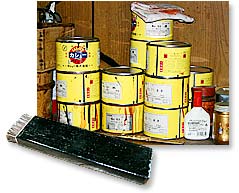 |
|
Can of cashew lacquer (above) and brush for lacquerware (below)
|
|
 |
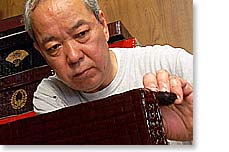 |
| Happiness of my work |
 |
| Although I have made lots of Tsuzura by now, it is not easy to make myself satisfied. When I am concentrating, sometimes I can produce a perfect product. When that happens, I am fully content. Also, I get very happy when I receive thank you letters or calls from customers who received the product. Their happiness supports my daily work. |
|
 |
 |
| Power of Amazake yokocho street, Nihonbashi |
 |
| It is a big plus that we have our store here in Amazake yokocho street,
Nihonbashi. Thanks to TV and other media coverage of our shop, we have visitors constantly. Since Ningyocho retains the atmosphere of the Edo tradition, visitors expect that, and we have groups of school students or companies for sightseeing purposes. These are all brought by this particular town of Ningyocho, Nihonbashi, so I am very grateful to this town.
|
|
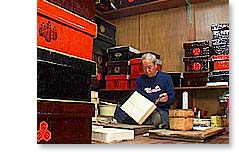 |
|
 |